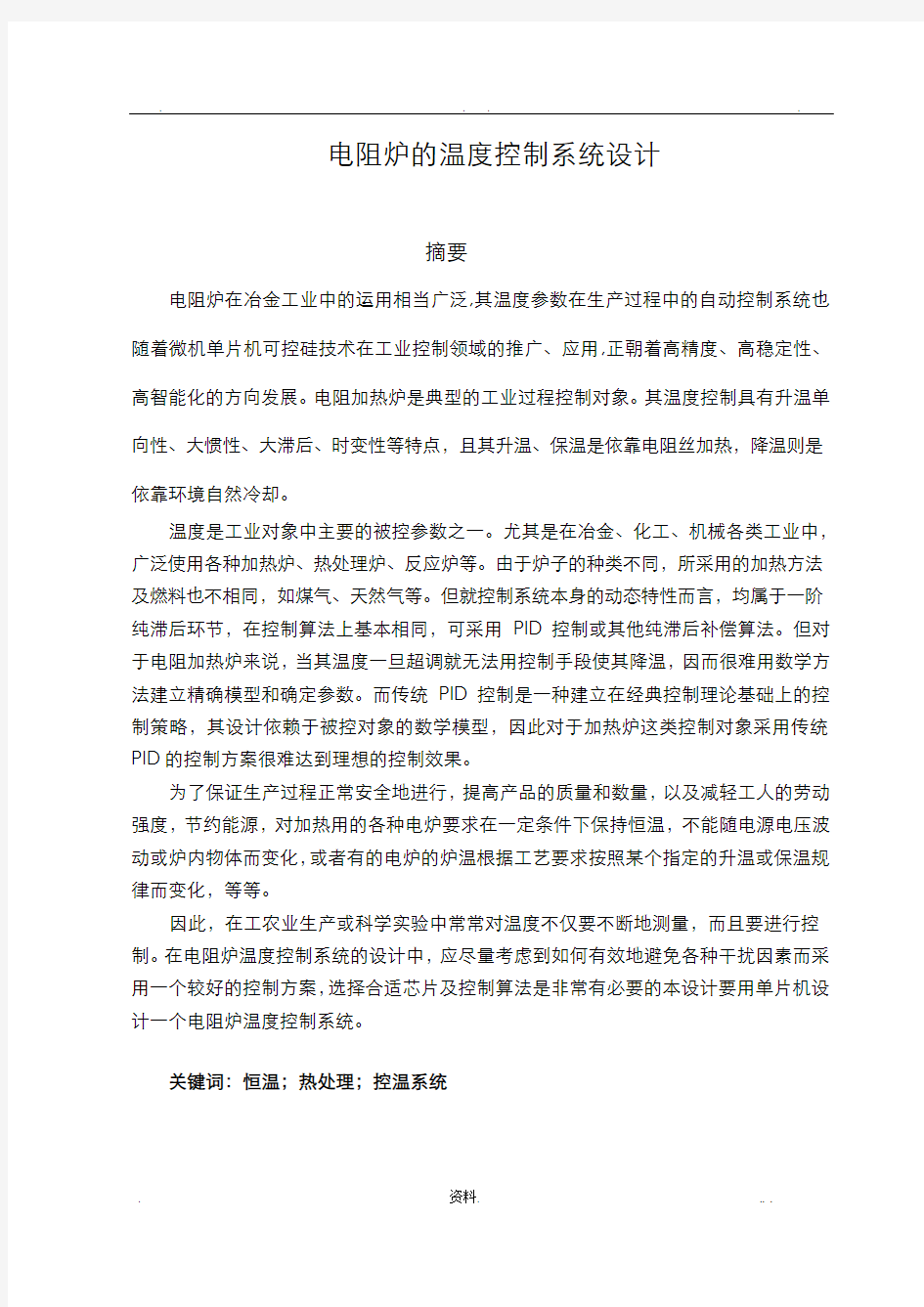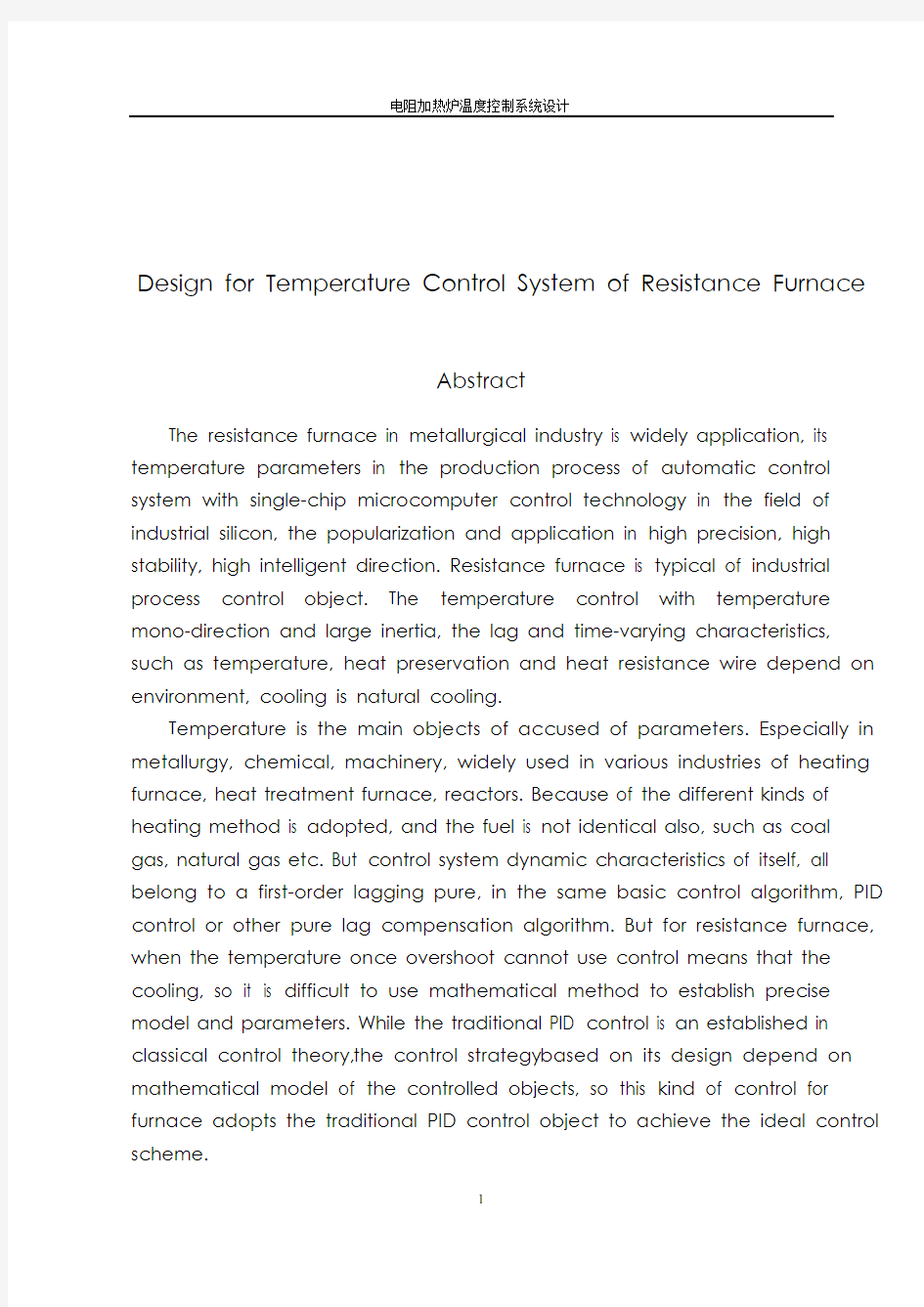电阻炉的温度控制系统设计课程设计报告


. . . .
电阻炉的温度控制系统设计
摘要
电阻炉在冶金工业中的运用相当广泛,其温度参数在生产过程中的自动控制系统也随着微机单片机可控硅技术在工业控制领域的推广、应用,正朝着高精度、高稳定性、高智能化的方向发展。电阻加热炉是典型的工业过程控制对象。其温度控制具有升温单向性、大惯性、大滞后、时变性等特点,且其升温、保温是依靠电阻丝加热,降温则是依靠环境自然冷却。
温度是工业对象中主要的被控参数之一。尤其是在冶金、化工、机械各类工业中,广泛使用各种加热炉、热处理炉、反应炉等。由于炉子的种类不同,所采用的加热方法及燃料也不相同,如煤气、天然气等。但就控制系统本身的动态特性而言,均属于一阶纯滞后环节,在控制算法上基本相同,可采用PID控制或其他纯滞后补偿算法。但对于电阻加热炉来说,当其温度一旦超调就无法用控制手段使其降温,因而很难用数学方法建立精确模型和确定参数。而传统PID控制是一种建立在经典控制理论基础上的控制策略,其设计依赖于被控对象的数学模型,因此对于加热炉这类控制对象采用传统PID的控制方案很难达到理想的控制效果。
为了保证生产过程正常安全地进行,提高产品的质量和数量,以及减轻工人的劳动强度,节约能源,对加热用的各种电炉要求在一定条件下保持恒温,不能随电源电压波动或炉内物体而变化,或者有的电炉的炉温根据工艺要求按照某个指定的升温或保温规律而变化,等等。
因此,在工农业生产或科学实验中常常对温度不仅要不断地测量,而且要进行控制。在电阻炉温度控制系统的设计中,应尽量考虑到如何有效地避免各种干扰因素而采用一个较好的控制方案,选择合适芯片及控制算法是非常有必要的本设计要用单片机设计一个电阻炉温度控制系统。
关键词:恒温;热处理;控温系统
Design for Temperature Control System of Resistance Furnace
Abstract
The resistance furnace in metallurgical industry is widely application, its temperature parameters in the production process of automatic control system with single-chip microcomputer control technology in the field of industrial silicon, the popularization and application in high precision, high stability, high intelligent direction. Resistance furnace is typical of industrial process control object. The temperature control with temperature mono-direction and large inertia, the lag and time-varying characteristics, such as temperature, heat preservation and heat resistance wire depend on environment, cooling is natural cooling.
Temperature is the main objects of accused of parameters. Especially in metallurgy, chemical, machinery, widely used in various industries of heating furnace, heat treatment furnace, reactors. Because of the different kinds of heating method is adopted, and the fuel is not identical also, such as coal gas, natural gas etc. But control system dynamic characteristics of itself, all belong to a first-order lagging pure, in the same basic control algorithm, PID control or other pure lag compensation algorithm. But for resistance furnace, when the temperature once overshoot cannot use control means that the cooling, so it is difficult to use mathematical method to establish precise model and parameters. While the traditional PID control is an established in classical control theory, the control strategy based on its design depend on mathematical model of the controlled objects, so this kind of control for furnace adopts the traditional PID control object to achieve the ideal control scheme.
In order to guarantee the normal production process, improve product safely quantity and quality and to reduce the labor intensity, energy saving, with all kinds of electric heating requirements under certain conditions, not with remains constant voltage fluctuations or furnace changes, or some objects according to the technical requirement of electric furnace temperature or a designated in accordance with the law and heat changes, etc.
Therefore, in industrial and agricultural production and scientific experiments to constantly measuring temperature will not only, and to control System.In the resistance furnace temperature control system design, should try to consider how to effectively avoid distractions and USES a better control scheme, select the appropriate chip and control algorithm is necessary to the design with a single-chip microcomputer temperature control system of resistance furnace.
Keywords: temperature;Heat treatment;Temperature control system
目录
摘要 (1)
Abstract (2)
一、总体方案设计 (4)
1、设计内容及要求 (4)
2、工艺要求 (4)
3、要求实现的系统基本功能 (5)
4、对象分析 (5)
5、系统功能设计 (5)
二、硬件的设计和实现 (5)
1、计算机机型 (5)
2、设计支持计算机工作的外围电路 (5)
3、设计输入输出通道 (8)
4、元器件的选择 (10)
三、数字控制器的设计 (7)
1、控制算法 (10)
2、计算过程 (11)
四、软件设计 (12)
1、系统程序流程图 (12)
2、程序清单 (15)
五、完整的系统电路图 (27)
六、系统调试 (27)
七、设计总结 (27)
八、参考文献 (27)
附录 (28)
一、总体方案设计
设计任务:用一台计算机及相应的部件组成电阻炉炉温的自动控制系统,并使系统达到工艺要求的性能指标。
1、设计内容及要求
电阻加热炉用于合金钢产品热力特性实验,电加热炉用电炉丝提供功率,使其在预定的时间内将炉内温度稳定到给定的温度值。在本控制对象电阻加热炉功率为8KW,有220V交流电源供电,采用双向可控硅进行控制。
系统模型:
2、工艺要求
按照规定的曲线进行升温和降温,温度控制范围为50~350℃,升温和降温阶段的温度控制精度为±5℃,保温阶段温度控制精度为±2℃。
3、要求实现的系统基本功能
微机自动调节:正常工况下,系统投入自动。
模拟手动操作:当系统发生异常,投入手动控制。
微机监控功能:显示当前被控量的设定值、实际值,控制量的输出值,参数报警时
有灯光报警。
4、对象分析
在此设计中,要求电阻炉炉内的温度,按照上图所示工艺要求的规律变化,首先从室温开始到50℃为自由升温阶段,当温度到达50℃,就进入系统调节,当温度上升到达350℃时进入保温段,要求始终在系统控制下,保证所需的炉内温度的精度。加工完毕,要进行降温控制。保温段的时间为600~1800s。过渡过程时间:即从开始控制到进入保温阶段的时间要小于600s。在保温段当温度高于352℃或低于348℃时要报警,在升温和降温阶段也要进行控制,使炉内温度按照曲线的斜率升或降。
采用MCS—51单片机作为控制器,ADC0809模数转换芯片为模拟量输入,DAC0832数模转换芯片为模拟量输出,铂电阻为温度检测元件,运算放大器和可控硅作为功率放大,电阻炉为被控对象,组成电阻炉炉温控制系统,另外,系统还配有数字显示,以便显示和记录生产过程中的温度和输出值。
5、系统功能设计
计算机定时对炉温进行测量和控制一次,炉内温度是由铂电阻温度计来进行测量,其信号经放大送到模数转换芯片,换算成相应的数字量后,再送入计算机中进行判别和运算,得到应有的电功率数,经过数模转换芯片转换成模拟量信号,供给可控硅功率调节器进行调节,使其达到炉温变化曲线的要求。
二、硬件的设计和实现
1、计算机机型:MCS—51 8031(不包含ROM、EPROM)
系统总线:PC总线
2、设计支持计算机工作的外围电路
矩阵键盘技术:
图2-1用8255接口的4×8键盘矩阵
图2-1为4×8矩阵组成的32键盘与微机接口电路。图中8255端口C为行扫描口,工作于输出方式,端口A工作于输入方式,用来读入列值。图中I/O口地址必须满足___CE=0,才能选中相应的寄存器。在每一行与列的交叉点接一个按键,故4×8共32个键。
温度输出显示技术:
LED静态显示接口技术,所谓静态显示,即CPU输出显示值后,由硬件保存输出值,保持显示结果.
图2-2用锁存器连接的6位静态显示电路
图2-2为6位BCD码静态显示电路原理图。图中74LS244为总线驱动器,6位数字显示共用同一组总线,每个LED显示器均配有一个锁存器(74LS377),用来锁存待显示的数据。当被显示的数据从数据总线经74LS244传送到各锁存器的输入端后,到底哪一个锁存器选通,取决于地址译码器74LS138各输出位的状态。总线驱动器74LS244由IOW和A9控制,当IOW和A9同时为低电平时,74LS244打开,将数据总线上的数据传送到各个显示器的锁存器74LS377上。
特点:占用机时少,显示可靠.但使用元件多,且线路复杂、成本高。
报警电路设计:
正常运行时绿灯亮,在保温阶段炉内温度超出系统允差范围,就要进行报警。报警时报警红灯亮,电笛响,同时发送中断信号至CPU进行处理。如图2-3
